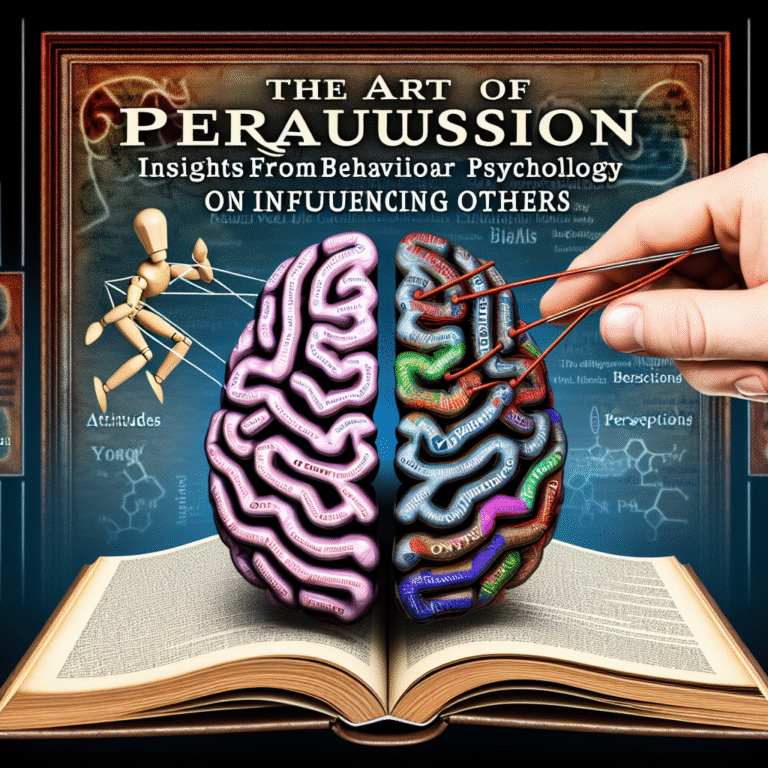
Breaking the Stress Cycle: Proven Behavioral Psychology Strategies for a Healthier Mindset
Introduction
In today’s fast-paced world, stress has become a common thread in our daily lives, affecting our mental and physical health. Understanding how to break this stress cycle is crucial for fostering a healthier mindset. With behavioral psychology strategies, we can not only address the symptoms but tackle the underlying patterns that perpetuate stress. This article delves into these strategies, offering valuable insights to empower you to reclaim your mental well-being.
Understanding the Stress Cycle
What is the Stress Cycle?
The stress cycle refers to the repetitive pattern in which stress triggers negative thoughts and behaviors, leading to increased anxiety and tension. To break the stress cycle is to interrupt this pattern, fostering resilience and healthier coping mechanisms.
The Impact of Stress on Mental Health
Chronic stress can lead to anxiety disorders, depression, and other mental health issues. According to the American Psychological Association, prolonged stress can suppress the immune system, raising the risk for illness. Understanding these implications emphasizes the importance of breaking the stress cycle through effective strategies.
Case Study: Jamie’s Journey
Background: Jamie, a 32-year-old marketing executive, noticed that her stress was impacting her work performance and personal relationships.
Application of Behavioral Strategies: She began practicing mindfulness and cognitive-behavioral techniques. After several months, Jamie reported feeling less overwhelmed and more in control of her emotions. This case illustrates how targeted strategies can yield significant improvements in quality of life.
Key Behavioral Psychology Strategies for Breaking the Stress Cycle
1. Cognitive Behavioral Therapy (CBT)
CBT is a widely recognized approach for breaking the stress cycle. It focuses on identifying and changing negative thought patterns that contribute to stress.
How It Works
- Cognitive Restructuring: Challenge and reframe negative thoughts.
- Behavioral Activation: Engage in activities that boost mood and self-esteem.
Case Study: Tom’s Transformation
Background: Tom struggled with chronic stress due to work pressure.
Application of CBT: By working with a therapist, he learned to identify his automatic negative thoughts and replace them with more constructive beliefs. This change allowed him to approach his work with a healthier mindset, reducing his overall stress levels.
2. Mindfulness and Meditation
Mindfulness practices increase awareness of the present moment, reducing anxiety about the future and regret about the past.
Benefits of Mindfulness
- Lower Stress Levels: Regular practice can lower cortisol levels.
- Enhanced Focus: Improves attention span and cognitive flexibility.
Case Study: Sara’s Serenity
Background: Sara experienced overwhelming stress due to family responsibilities.
Application of Mindfulness: After joining a mindfulness meditation group, she reported significant improvements in her emotional regulation and overall well-being. This showcases the power of mindfulness in breaking the stress cycle.
3. Physical Activity
Regular exercise is effective in managing stress. The endorphins released during physical activity act as natural stress relievers.
Incorporating Physical Activity
- Set Goals: Establish achievable fitness goals.
- Find Enjoyment: Select activities you enjoy to create a sustainable routine.
Case Study: Mark’s Moves
Background: Mark, a high-school teacher, faced end-of-year stress.
Application of Regular Exercise: He began running every morning, which not only improved his mood but also increased his productivity in the classroom, illustrating how physical activity can help break the stress cycle.
Table: Benefits of Various Stress-Breaking Activities
| Activity Type | Benefits | Recommended Frequency |
|---|---|---|
| Mindfulness Meditation | Reduces anxiety, improves focus | Daily |
| Regular Exercise | Boosts mood, increases resilience | 3-5 times weekly |
| Journaling | Enhances self-reflection and clarity | Several times a week |
| Social Interaction | Provides emotional support | Regularly |
4. Developing Healthy Coping Mechanisms
Finding constructive ways to cope with stress is vital. Avoiding unhealthy coping mechanisms, such as excessive drinking or procrastination, is essential in breaking the cycle.
Healthy Coping Strategies
- Problem-solving: Take actionable steps to resolve stressors.
- Support Networks: Lean on friends and family for support.
Case Study: Linda’s Breakthrough
Background: Linda relied on caffeine and late-night TV to cope with stress.
Application of Healthy Strategies: She switched to herbal teas and started a book club. This transformation led to improved sleep and reduced stress, showcasing how healthy coping strategies can effectively break the stress cycle.
5. Time Management Techniques
Poor time management often leads to feeling overwhelmed. Learning to prioritize tasks can significantly reduce stress.
Effective Time Management Strategies
- Task List: Create daily task lists to outline priorities.
- Time Blocking: Allocate specific time slots for focused work.
Case Study: Kevin’s Control
Background: Kevin often felt stressed due to last-minute deadlines at work.
Application of Time Management: After adopting a time-blocking method, he found himself less rushed and more productive. His experience emphasizes the role of organization in breaking the stress cycle.
Creating Your Stress-Breaking Plan
To truly benefit from the behavioral strategies discussed, it’s essential to create a tailored plan to address your unique stressors.
Step 1: Identify Your Triggers
Keep a journal to track when you feel stressed and what specific situations lead to these feelings.
Step 2: Set Clear Goals
Establish realistic, measurable goals to incorporate the stress-breaking strategies you’ve learned.
Step 3: Regularly Review and Adjust
Periodically evaluate your progress and make adjustments as needed. This reflective practice is essential in maintaining a healthier mindset.
Conclusion
Breaking the stress cycle is not merely about reducing current stress levels; it’s a lifelong commitment to cultivating a healthier mindset through behavioral psychology strategies. By applying techniques such as CBT, mindfulness, physical activity, healthy coping mechanisms, and time management, you can reclaim control over your stress responses and enhance your overall well-being. Remember, every step you take towards managing stress contributes to a healthier, more fulfilling life.
FAQs
1. What are some quick ways to reduce stress in the moment?
Practices such as deep breathing exercises, taking a short walk, or practicing gratitude can provide instant relief.
2. How long does it take to see results from these strategies?
Results can vary; however, many people start feeling relief within a few weeks of consistently practicing these strategies.
3. Can I break the stress cycle without professional help?
Many individuals successfully implement these strategies independently, though seeking professional guidance can provide additional support and tailored approaches.
4. Are there any risks associated with these strategies?
While generally safe, it’s important to discuss any new mental health practices with a healthcare provider, especially if you have existing mental health conditions.
5. How can I motivate myself to stick to a stress-busting plan?
Try setting small, achievable goals and rewarding yourself for progress. Joining support groups can also encourage accountability and motivation.
In conclusion, breaking the stress cycle through behavioral psychology strategies provides a pathway to a healthier mindset. Equip yourself with these tools and start your journey to well-being today!














